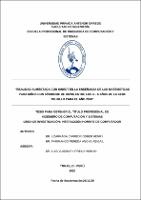Mostrar el registro sencillo del ítem
Realidad aumentada con Kinect en la enseñanza de las matemáticas para niños con síndrome de Down entre los 3-6 años de la CEBE Trujillo para el año 2020
| dc.contributor.advisor | Urrelo Huiman, Luis Valdimir | |
| dc.contributor.author | Lizarraga Chimbor, Osber Henry | |
| dc.contributor.author | Parimango Pereda, Angye Abigail | |
| dc.creator | Lizarraga Chimbor, Osber Henry | |
| dc.date.accessioned | 2020-12-11T12:52:48Z | |
| dc.date.available | 2020-12-11T12:52:48Z | |
| dc.date.issued | 2020 | |
| dc.identifier.uri | https://hdl.handle.net/20.500.12759/6926 | |
| dc.description.abstract | El presente trabajo de investigación, tiene como objetivo desarrollar una aplicación de Realidad Aumentada basada en tecnología Kinect para complementar el desarrollo en el aprendizaje de las matemáticas de niños entre 3 a 6 años con Síndrome de Down del Centro de Educación Básica Especial Trujillo en el año 2020. Para lograr alcanzar el objetivo planteado se determinó estudiar las características del proceso de enseñanza en niños con Síndrome de Down (SD) en la institución y determinar los problemas que existen durante el proceso, a través de 3 entrevistas y 2 cuestionarios realizados a la directora y docentes de la institución se logró identificar las debilidades que presentan los niños durante el aprendizaje. Para el desarrollo de toda la aplicación fue necesario determinar los requerimientos dado por las docentes y haciendo uso de herramientas tecnológicas como la metodología ICONIX. Se utilizó la herramienta de Unity 3D bajo un lenguaje de programación orientado a objetos C#, además de todo el kit que comprende la tecnología Kinect. Alrededor de 8 meses hemos trabajado en unión con los docentes que laboran en la CEBE Trujillo y teniendo en cuenta las características de enseñanza y sesiones según su malla curricular para el desarrollo de la aplicación de tal manera se convierta en una herramienta pedagógica de apoyo al docente al momento de realizar las sesiones de clase, logrando una mayor participación y motivación en el aprendizaje de los niños con SD. La característica a destacar de esta aplicación es el uso de la realidad aumentada con el Kinect donde el usuario podrá interactuar con la consola sin la necesidad de hacer contacto físico, de esa manera los niños lograrán mayor concentración y atención de los temas que se pretenden enseñar y sin tener una dependencia de algún dispositivo móvil. | es_PE |
| dc.description.abstract | The present research work aims to develop an Augmented Reality application based on Kinect technology to complement the development in learning mathematics of children between 3 to 6 years old with Down Syndrome from the Trujillo Special Basic Education Center in the year 2020. In order to achieve the proposed objective, it was determined to study the characteristics of the teaching process in children with Down Syndrome (DS) in the institution and determine the problems that exist during the process, through 3 interviews and 2 questionnaires made to the The director and teachers of the institution were able to identify the weaknesses that children present during learning. For the development of the entire application, it was necessary to determine the requirements given by the teachers and using technological tools such as the ICONIX methodology. The Unity 3D tool was used under an object-oriented programming language C #, in addition to the entire kit that includes Kinect technology. For about 8 months we have worked in conjunction with the teachers who work at CEBE Trujillo and taking into account the characteristics of teaching and sessions according to their curricular mesh for the development of the application in such a way that it becomes a pedagogical tool to support the teacher at the time of class sessions, achieving greater participation and motivation in the learning of children with DS. The highlight of this application is the use of augmented reality with the Kinect where the user can interact with the console without the need to make physical contact, in this way the children will achieve greater concentration and attention on the topics that are intended to be taught and without having a dependency on a mobile device. | en_US |
| dc.description.uri | Tesis | es_PE |
| dc.format | application/pdf | es_PE |
| dc.language.iso | spa | es_PE |
| dc.publisher | Universidad Privada Antenor Orrego | es_PE |
| dc.relation.ispartofseries | T_ING.SIST_1475 | |
| dc.rights | info:eu-repo/semantics/openAccess | es_PE |
| dc.rights.uri | https://creativecommons.org/licenses/by/4.0/ | es_PE |
| dc.source | Universidad Privada Antenor Orrego | es_PE |
| dc.source | Repositorio Institucional - UPAO | es_PE |
| dc.subject | Realidad aumentada | es_PE |
| dc.subject | Kinect | es_PE |
| dc.title | Realidad aumentada con Kinect en la enseñanza de las matemáticas para niños con síndrome de Down entre los 3-6 años de la CEBE Trujillo para el año 2020 | es_PE |
| dc.type | info:eu-repo/semantics/bachelorThesis | es_PE |
| thesis.degree.level | Título Profesional | es_PE |
| thesis.degree.grantor | Universidad Privada Antenor Orrego. Facultad de Ingeniería | es_PE |
| thesis.degree.name | Ingeniero de Computación y Sistemas | es_PE |
| thesis.degree.discipline | Ingeniería de Computación y Sistemas | es_PE |
| dc.subject.ocde | https://purl.org/pe-repo/ocde/ford#2.02.04 | es_PE |
| renati.type | https://purl.org/pe-repo/renati/type#tesis | es_PE |
| renati.level | https://purl.org/pe-repo/renati/level#tituloProfesional | es_PE |
| renati.discipline | 611066 | es_PE |
| dc.publisher.country | PE | es_PE |


